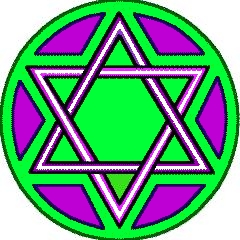Star of David
The Magen David (shield of David) is a six-pointed star which has come to symbolize Judaism and the Jewish people. Despite its name, the association of the six-pointed star with the Jewish people is relatively recent. The first known connection was in 1354 when Emperor Charles IV of Czechoslovakia permitted the Jewish community to create its own flag. They employed two gold six-pointed star on their banner and used it to welcome the king to the city of Prague, in addition to two red pentacles (five-pointed stars, known as Solomon's Seal).
 It was certainly used in the ancient world, as early as the Bronze Age (most likely as a magical sign) from Mesopotamia to Britain, but it was not clearly connected with the Jewish people at this point in history. The second-third century C.E. synagogue of Capernaum contained a stone frieze in which was carved hexagrams, pentagrams and even a swastika. It is not known precisely what these geometric designs meant during this time period. The assumptions is that the designs were purely decorative and did not connote anything of religious significance.
It was certainly used in the ancient world, as early as the Bronze Age (most likely as a magical sign) from Mesopotamia to Britain, but it was not clearly connected with the Jewish people at this point in history. The second-third century C.E. synagogue of Capernaum contained a stone frieze in which was carved hexagrams, pentagrams and even a swastika. It is not known precisely what these geometric designs meant during this time period. The assumptions is that the designs were purely decorative and did not connote anything of religious significance.
The hexagram first appears as a magical symbol in the early Middle Ages, especially in Muslim and Christian countries, and was used on notarial seals as well as for architectural decoration on churches. It appears that the hexagram was employed even earlier by the Karraite Judah Hadassi in the mid-12th century in connection with amulets and names for God. However, at this time it did not symbolize either God or the Jewish people; its precise meaning is unclear, but scholars have suggested that it suggested God's protecting power, hence the association with a "shield." The star was also employed in Kabbalah at this time; the ten sefirot were arranged within the six-pointed star and it was used in amulets. It further appears that the hexagram and pentagram were used interchangeably until this period, and then the six-pointed star gained favor, as it was associated with the notion of a "shield" of God and taken to have magical powers when used as an amulet. From the 14th century through the 18th century, the terms "shield of David" and "seal of Solomon" were used in magical texts indiscriminately though the hexagram ascended in popularity as the pentagram diminished in popularity. It is in this context that the Prague Jewish community chose to use the hexagram as its symbol when King Charles IV granted them the privilege of having their own flag in 1354.
Theodor Herzl popularized the symbol when he chose it to represent his new Zionist Movement. The first issue of the Zionist journal Die Welt, featured a Magen David. In the 19th century, Jews wanted to have a simple geometric symbol to identify Judaism in the manner in which the Christian community employed the cross. The hexagram served that purpose well. The philosopher Franz Rosenzweig employed the star as a motif for structuring his ideas about the the relationships between God, Jews, and the world, in a work entitled Der Stern der Erloesung (The Star of Redemption, 1921).
During the Nazi era, Jews were forced to sew yellow six-pointed stars to their clothing in order to identify them as Jews and separate them from the rest of the population. This facilitated rounding Jews up for transportation to ghettos, concentration camps and death camps. It was intended to be a sign of humiliation. Shortly after World War II, however, the star was placed on a field of white between two blue stripes (the white field and blue stripes symbolizing the tallit) becoming the flag of the newly reborn State of Israel, once again a symbol of pride and belonging.
Today, the six-pointed star is a proud symbol of an ancient heritage and is used to adorn and decorate many ritual objects. It has even been used as the basis of architectural plans for synagogues and other buildings of the Jewish community.
More Rituals and Practices:
 It was certainly used in the ancient world, as early as the Bronze Age (most likely as a magical sign) from Mesopotamia to Britain, but it was not clearly connected with the Jewish people at this point in history. The second-third century C.E. synagogue of Capernaum contained a stone frieze in which was carved hexagrams, pentagrams and even a swastika. It is not known precisely what these geometric designs meant during this time period. The assumptions is that the designs were purely decorative and did not connote anything of religious significance.
It was certainly used in the ancient world, as early as the Bronze Age (most likely as a magical sign) from Mesopotamia to Britain, but it was not clearly connected with the Jewish people at this point in history. The second-third century C.E. synagogue of Capernaum contained a stone frieze in which was carved hexagrams, pentagrams and even a swastika. It is not known precisely what these geometric designs meant during this time period. The assumptions is that the designs were purely decorative and did not connote anything of religious significance.